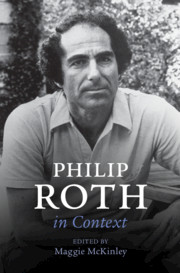Book contents
- Philip Roth in Context
- Philip Roth in Context
- Copyright page
- Contents
- Notes on Contributors
- A Note on References and Abbreviations
- Introduction
- Part I Life and Literary Contexts
- Part II Critical Contexts
- Part III Geographical Contexts
- Part IV Theoretical Contexts
- Part V Jewish American Identity
- Chapter 20 Roth as “Jewish American Writer”
- Chapter 21 Judaism and Secularism
- Chapter 22 Roth and the Holocaust
- Chapter 23 Antisemitism
- Chapter 24 The Black-Jewish Matrix
- Part VI Gender and Sexuality
- Part VII Political Contexts
- Part VIII Roth’s Legacy
- Primary Bibliography
- Selected Secondary Bibliography
- Index
Chapter 21 - Judaism and Secularism
from Part V - Jewish American Identity
Published online by Cambridge University Press: 15 July 2021
- Philip Roth in Context
- Philip Roth in Context
- Copyright page
- Contents
- Notes on Contributors
- A Note on References and Abbreviations
- Introduction
- Part I Life and Literary Contexts
- Part II Critical Contexts
- Part III Geographical Contexts
- Part IV Theoretical Contexts
- Part V Jewish American Identity
- Chapter 20 Roth as “Jewish American Writer”
- Chapter 21 Judaism and Secularism
- Chapter 22 Roth and the Holocaust
- Chapter 23 Antisemitism
- Chapter 24 The Black-Jewish Matrix
- Part VI Gender and Sexuality
- Part VII Political Contexts
- Part VIII Roth’s Legacy
- Primary Bibliography
- Selected Secondary Bibliography
- Index
Summary
Roth’s fiction is, for the most part, set in America, in the years following World War II. None of his works are directly situated during the Holocaust, but many of his works are gounded in allusions to that tragedy. This chapter will situate a discussion of those allusions within a larger discussion of the problematic ways in which the Holocaust has in large part come to define Jewish identity, a subject taken up by Roth in works like Portnoy’s Complaint and The Ghost Writer. There, Roth pushes back on associations between Jewishnesss and victimization, but also acknowledges the necessity of contending with the Holocaust as an integral part of collective Jewish identity, thus opening up a conversation continued in more recent works like Nathan Englander’s “What We Talk About When We Talk About Anne Frank.”
- Type
- Chapter
- Information
- Philip Roth in Context , pp. 215 - 229Publisher: Cambridge University PressPrint publication year: 2021

